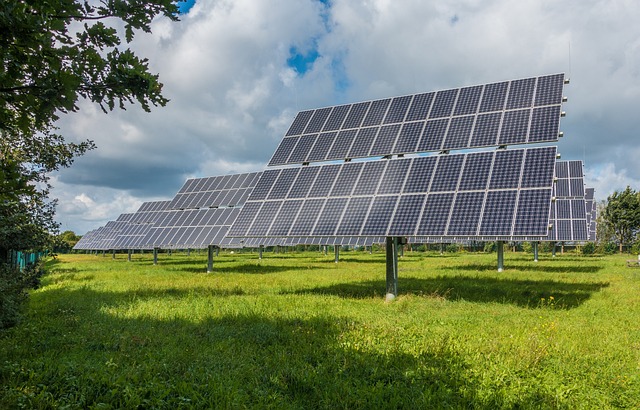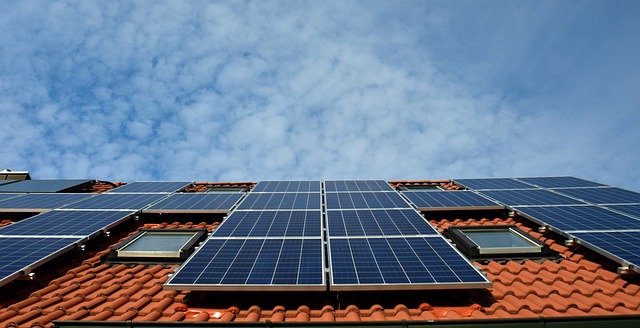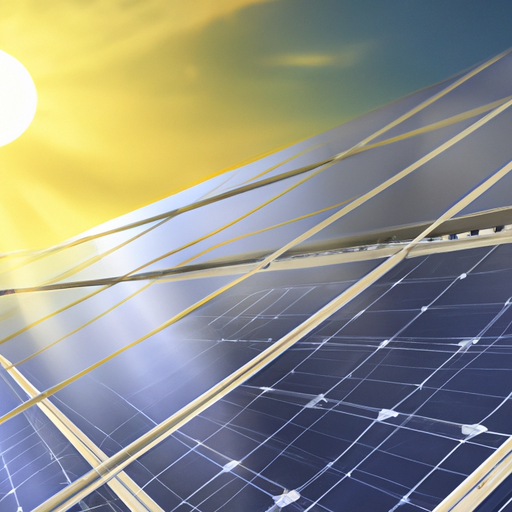Are you curious about the difference between on-grid and off-grid solar systems? In our latest article, we break down the key distinctions between these two types of solar setups. By understanding the advantages and disadvantages of each, you’ll be able to make an informed decision about which system is right for you. Whether you’re looking to reduce your carbon footprint or gain energy independence, this article will provide you with all the information you need to embark on your solar journey. Stay tuned and get ready to dive into the world of solar energy with us!

This image is property of pixabay.com.
On-grid Solar Systems
Definition
An on-grid solar system, also known as a grid-tied solar system, is a solar power system that is connected to the electrical grid. It works in synchronization with the grid, allowing the excess electricity generated by the solar panels to be supplied back to the grid. This means that the power generated by an on-grid solar system can be used to offset the electricity consumption from the grid, resulting in potential cost savings.
Connection to the Grid
To connect an on-grid solar system to the grid, a bi-directional meter is installed by the utility company. This meter measures both the electricity consumed from the grid and the electricity supplied back to the grid from the solar system. This arrangement enables the homeowner to take advantage of net metering, a system where any excess electricity generated during the day can be credited and used during times when the solar panels are not producing enough power, such as at night or during cloudy weather.
Benefits
One of the key benefits of an on-grid solar system is its ability to reduce or eliminate electricity bills. By generating your own clean energy from the sun, you can offset a significant portion of your electricity consumption, resulting in substantial savings over time. Additionally, by being connected to the grid, you have access to a reliable source of electricity whenever your solar panels are not producing enough power, ensuring uninterrupted power supply.
Moreover, on-grid solar systems require less maintenance compared to their off-grid counterparts, as they do not rely on batteries for energy storage. This reduces both the upfront costs and the long-term maintenance costs associated with battery replacement and upkeep.
Drawbacks
The main drawback of on-grid solar systems is their reliance on the electrical grid. Since they are connected to the grid, they are susceptible to grid outages. In the event of a power outage, an on-grid solar system will automatically shut down to ensure the safety of utility workers who may be repairing the grid. This means that even if you have solar panels, you will not have power during a grid outage unless you have a backup power source.
Additionally, on-grid solar systems are dependent on the availability of sunlight to generate electricity. If you live in an area with frequent cloudy weather or limited sunlight, the performance of your on-grid solar system may be affected, resulting in lower electricity generation.
Off-grid Solar Systems
Definition
An off-grid solar system, also known as a standalone solar system, is a solar power system that operates independently of the electrical grid. It is designed to provide electricity to properties that are not connected to the grid or in remote areas where grid connection is not feasible. Off-grid solar systems rely on batteries to store excess power generated during the day, which can then be used to provide electricity during times when the solar panels are not producing enough energy, such as at night or during periods of low sunlight.
Independence from the Grid
One of the key advantages of off-grid solar systems is their ability to provide complete energy independence. Since they are not connected to the grid, off-grid systems are not affected by power outages or fluctuations in grid voltage. This makes them an ideal choice for remote areas where grid connection is either unavailable or unreliable.
Benefits
Apart from providing energy independence, off-grid solar systems offer several other benefits. They allow homeowners to live in locations that would otherwise be unsuitable for conventional electricity connections. By harnessing the power of the sun, off-grid solar systems can bring electricity to remote areas, enabling sustainable development and improving the quality of life for people living in off-grid locations.
Furthermore, off-grid solar systems are environmentally friendly, as they rely solely on renewable energy sources. By reducing reliance on fossil fuels, these systems contribute to the reduction of greenhouse gas emissions and help combat climate change.
Drawbacks
The main drawback of off-grid solar systems is the reliance on batteries for energy storage. Batteries are an essential component of off-grid systems, as they store excess energy for use during periods of low sunlight or at night. However, batteries have a limited lifespan and will eventually need to be replaced, adding to the overall maintenance costs of the system.
Moreover, off-grid solar systems require careful planning and sizing to ensure that they meet the electricity demands of the property. Oversizing or undersizing the system can result in either wasted energy or insufficient power supply, which can be costly and inconvenient.

This image is property of pixabay.com.
Comparison
Energy Independence
When it comes to energy independence, off-grid solar systems clearly have the upper hand. They provide complete autonomy and are not affected by power outages or fluctuations in grid voltage. On the other hand, on-grid solar systems rely on the grid for backup power during times of low sunlight or system failure.
Cost
The cost of installing an on-grid solar system is generally lower than that of an off-grid system. This is because off-grid systems require additional components such as batteries, charge controllers, and inverters to store and convert the energy generated by the solar panels. Additionally, ongoing maintenance costs are generally higher for off-grid systems due to the need to replace batteries.
However, it’s important to note that the cost of electricity from an on-grid system is subject to utility rates, which can fluctuate over time. In contrast, off-grid systems provide a fixed and predictable source of electricity at a relatively constant cost.
Reliability
On-grid solar systems have a higher level of reliability compared to off-grid systems. They are constantly connected to the grid, which provides a reliable source of power during periods of low sunlight or system failure. Off-grid systems, on the other hand, rely solely on solar energy and battery storage, making them more susceptible to fluctuations in weather conditions and battery performance.
Environmental Impact
Both on-grid and off-grid solar systems have a positive environmental impact by reducing reliance on fossil fuels and reducing greenhouse gas emissions. However, on-grid systems have the potential to have a larger environmental impact, as excess electricity generated by the solar panels can be supplied back to the grid and used by other consumers.
Installation and Set-Up
On-grid Installation
Installing an on-grid solar system typically involves mounting solar panels on the roof or ground, wiring them to an inverter that converts the DC power generated by the panels into AC power, and connecting the inverter to the electrical panel of the property. A bi-directional meter is installed by the utility company to measure the electricity consumed from the grid and the electricity supplied back to the grid.
Off-grid Installation
Installing an off-grid solar system follows a similar process to on-grid systems but requires additional components to store and convert the solar energy. In addition to the solar panels and inverter, off-grid systems require batteries to store excess energy, charge controllers to regulate the charging of the batteries, and sometimes a backup generator for periods of low sunlight.
Required Equipment
The equipment required for an on-grid solar system includes solar panels, an inverter, mounting hardware, wiring, and a bi-directional meter. Off-grid systems require all of the same components as on-grid systems, with the addition of batteries, charge controllers, and sometimes a backup generator.

This image is property of pixabay.com.
Maintenance and Upkeep
On-grid Maintenance
On-grid solar systems require minimal maintenance, as they do not rely on batteries for energy storage. Regular cleaning of the solar panels to remove dirt and debris is recommended to ensure optimal performance. Additionally, periodic inspections by a solar professional can help identify and resolve any issues that may affect the system’s performance.
Off-grid Maintenance
Off-grid solar systems require more maintenance compared to on-grid systems due to the additional components involved, particularly the batteries. Regular battery maintenance, such as checking and adjusting water levels (for flooded lead-acid batteries) or monitoring the state of charge (for sealed batteries), is necessary to ensure their longevity and performance. It is also important to regularly clean the solar panels and conduct inspections to identify any potential issues.
Battery Maintenance
Batteries used in off-grid solar systems require regular maintenance to ensure optimal performance and prolong their lifespan. This includes checking and adjusting water levels (for flooded lead-acid batteries), monitoring the state of charge, and conducting regular capacity tests to determine the battery’s health and remaining capacity. Additionally, batteries should be kept in a cool and well-ventilated area to prevent overheating.
Financial Considerations
Cost of On-grid System
The cost of an on-grid solar system varies depending on factors such as the size of the system, the quality of the components used, and the installation costs. On average, a residential on-grid system can cost between $10,000 and $30,000, depending on the size and complexity of the installation. However, it is important to consider the long-term savings on electricity bills, as well as potential incentives and tax credits that may offset the upfront costs.
Cost of Off-grid System
Off-grid solar systems are generally more expensive than on-grid systems due to the additional components required, particularly the batteries. The cost of an off-grid system can range from $20,000 for a basic system that provides electricity to a small cabin or remote location to over $100,000 for a larger system that can power an entire off-grid property. The cost is highly dependent on the electricity demand and the number of days of autonomy required.
Return on Investment
Both on-grid and off-grid solar systems offer a return on investment through electricity cost savings over time. The payback period for an on-grid system is typically shorter, ranging from 5 to 10 years, depending on various factors such as electricity rates and system size. Off-grid systems have a longer payback period, usually between 10 and 20 years, due to the higher upfront costs and ongoing maintenance expenses.
It’s important to note that the return on investment for solar systems can vary depending on the specific circumstances and location. Incentives such as tax credits, grants, and net metering policies can also impact the financial viability of solar installations.

Suitability and Applications
On-grid Suitability
On-grid solar systems are suitable for properties that are connected to the electrical grid and have a reliable grid supply. They are ideal for homeowners who want to reduce their electricity bills and contribute to a greener environment without the need for backup power during grid outages.
Off-grid Suitability
Off-grid solar systems are suitable for properties that are not connected to the grid or in remote areas where grid connection is not feasible. They are ideal for homeowners who want complete energy independence and are willing to invest in the necessary equipment and maintenance.
Residential Applications
Both on-grid and off-grid solar systems have applications in residential settings. On-grid systems are more commonly used in urban and suburban areas, where grid connection is readily available. Off-grid systems are popular in rural areas, vacation homes, or isolated properties where grid connection is either unavailable or unreliable.
Commercial Applications
Solar power is becoming increasingly popular in commercial settings as businesses seek to reduce their carbon footprint and cut operating costs. On-grid solar systems are commonly used in commercial buildings, office complexes, and industrial facilities to offset electricity consumption and reduce energy bills. Off-grid systems can be deployed in remote commercial locations, such as mining sites or agricultural facilities, where grid connection is not practical.
Government Policies and Incentives
On-grid Policies and Incentives
Government policies and incentives for on-grid solar systems vary by country and region. Some common incentives include tax credits, grants, feed-in tariffs, and net metering programs. These programs aim to promote the adoption of solar energy and encourage homeowners and businesses to invest in renewable energy solutions.
Off-grid Policies and Incentives
Off-grid solar systems are often supported by government initiatives in remote and off-grid areas. These can include subsidies, grants, tax incentives, and funding support for projects that bring electricity to underserved communities. In some cases, governments may also provide technical assistance and capacity-building initiatives to help communities develop and manage their own off-grid solar systems.

Environmental Impact
On-grid Environmental Impact
On-grid solar systems have a positive environmental impact by reducing dependence on fossil fuels and lowering greenhouse gas emissions. By supplying excess electricity back to the grid, on-grid systems contribute to the overall reduction of carbon emissions from conventional power plants. Additionally, the use of renewable energy sources helps conserve natural resources and mitigate the environmental impact of electricity generation.
Off-grid Environmental Impact
Off-grid solar systems also have a positive environmental impact by eliminating the need for fossil fuel-based power generation in remote areas. By relying solely on solar energy, these systems reduce greenhouse gas emissions and air pollution. Additionally, off-grid systems promote sustainable development in remote communities, ensuring access to clean and reliable electricity without the need for extensive infrastructure.
Conclusion
In conclusion, the difference between on-grid and off-grid solar systems lies in their connection to the electrical grid, independence from the grid, and the specific applications they are suited for. On-grid solar systems are connected to the grid, allowing homeowners to offset their electricity consumption and potentially save on their electricity bills. They are ideal for grid-connected properties and offer a reliable source of power during grid outages.
Off-grid solar systems, on the other hand, operate independently of the grid and are suitable for properties located in remote areas or those seeking complete energy independence. While they require additional components and maintenance costs compared to on-grid systems, they offer complete autonomy and the ability to bring electricity to areas that would otherwise be without power.
When considering which solar system is right for you, it is important to evaluate your specific needs, budget, and location. Whether you opt for an on-grid or off-grid system, embracing solar power is a step towards a greener, more sustainable future. With the right information, resources, and support provided by HomeSolarDIY, you can confidently embark on your solar journey and make a positive impact on the environment while enjoying the benefits of clean, renewable energy. Remember, the power to change is in your hands!

